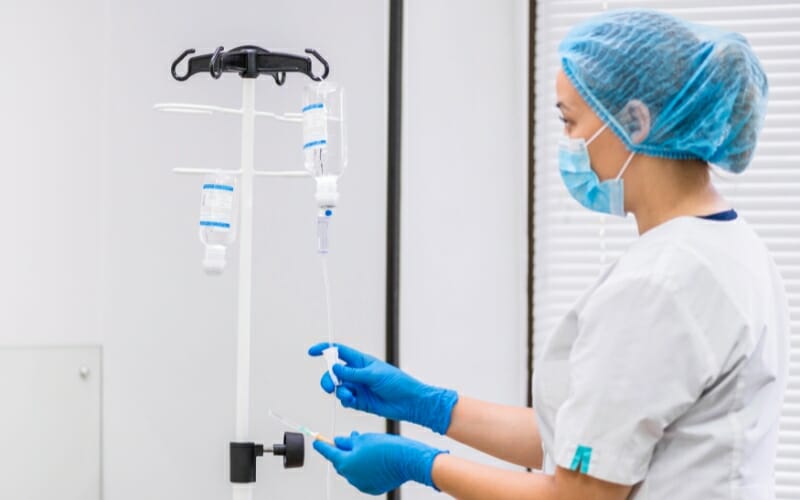IV therapy is a powerful treatment because it can accomplish many things.
Some folks may use it to recover energy levels from a triathlon, some may choose IV therapy for migraine relief, and others may use it to offer flu relief. What is put in your IV bag depends on what you are trying to accomplish. Some may contain Vitamin C, Vitamin D, or Vitamin B.
There are many potential options, so you’ll make the best choice for your health when you have information on what each ingredient does and how it can help you. Use this guide to learn all about IV drip ingredients for fluid replacement.
Saline Solution
IN THIS ARTICLE

IV fluids combine sodium chloride and sterile water.
- The water in your IV helps rehydrates your body
- Sodium chloride provides electrolytes. Electrolytes improve your immune system, stabilize blood sugar, repair tissues, and balance blood pressure balance.
- Dehydration upsets the body’s delicate balance of water and electrolytes, and IV fluids help your body restore that balance. The saline solution helps mitigate the psychological and physical and effects of dehydration, which include mental confusion, headaches, and aching joints.
- Saline fluids are an effective delivery mechanism for medications, minerals, and vitamins and vitamins. Utilizing an IV helps infuse everything directly into your blood cells and stream. This allows for the maximum absorption of all of these vital nutrients in your body.
What is Saline Solution Used For?
They are used to treat dehydration, flush wounds, administer diluted medications, and sustain patients through serious medical conditions such as surgery, dialysis, and chemotherapy. IV has optimal uses for both recovery and a medical emergency.
Saline solution combines sodium chloride and water at a concentration of 9 grams of salt per liter (a 0.9% solution). It is commonly called normal saline, though it may also be referred to as isotonic saline. This is because it is “physiologically normal”, even though it is not exactly like blood. However, it can be used in higher and lower concentrations.
Researchers have been concerned about the amount of sodium chloride in saline solution—one bag of saline solution has the same amount of sodium as twenty bags of potato chips.
Although this intravenous solution is given to about 80 percent of hospitalized patients, it is not the only solution.
Doctors have developed balanced fluids, which more closely resemble the chemistry and electrolyte balance of healthy blood in the human body.
How Effective is Saline Solution?

In a recent study published In the New England Journal of Medicine, researchers tested the effectiveness of IV saline solution and balanced fluids at Vanderbilt University.
For over a year, they used saline solution on even-numbered months and balanced fluids on odd-numbered months.
For balanced fluids, doctors had a choice between lactated Ringer’s or Plasma-Lyte-A. Compared to saline, these solutions have added electrolytes and less sodium. In this study, doctors chose lactated ringer’s more often.
Patients who participated in this study were followed for 30 days.
The study found that the chosen solution was most important for critical patients, especially those admitted to the intensive care unit (ICU). ICU patients were less likely to have injury to their kidneys, need dialysis, or die, as compared to patients who received saline treatments instead.
Statistically, the difference between the two groups was small but significant. There was an absolute difference of 1.1 percent.
In this trial, 1,139 patients out of the 7,942 that received balanced fluids had one of the aforementioned complications. Of those who received saline, 1,211 saw complications out of 7,860.
This difference may seem trivial, but when it is extrapolated on a greater scale, it becomes much more significant. For instance, 1.1 percent of 30 million patients would amount to 330,000 patients.
And that’s not a random figure; about 30 million people get hospitalized each year. As you can see, this small change can have a great impact on the well-being of hundreds of thousands of people.
The good news is that balanced fluids cost about the same per unit as saline solution, and they are easily accessible. Most suppliers already make both types, so switching to balanced fluids is not difficult or expensive for healthcare providers.
It is important to note that doctors did not test balanced fluids on all patients. Patients with brain injuries were exempt from the study because balanced fluids could have potentially impacted swelling, which is critical to control in these patients.
The study may have left room for bias.
It was not blinded—doctors, nurses, and patients knew what solutions they were getting, which could have swayed results. It was limited to a single hospital, though they are currently working on studies in other countries.
And the researchers didn’t provide a statistical breakdown of the effects of the solutions on different complications; instead, kidney problems and death were categorized together, though they are very, very different.
Since the study, Vanderbilt has decided to permanently switch to balanced fluids. Other doctors are seeing the value in switching, too. For those that are still uncertain, there are two more large-scale studies coming soon—from Brazil and Australia—that may be able to provide more insight.
Do You Need Help Administering Your IV?
As beneficial as an IV drip is, it can be stressful to set up and administer.
If you want a licensed professional to come to your home and administer your IV Therapy or if you’d like the best at-home education for setting everything up yourself, contact NurseRegistry today.
We have countless nurses that are friendly, professional, and always helpful. Plus, you can get the care you need, when you need it – anytime day or night. Click here to hire a private nurse today.
Sources:
https://en.wikipedia.org/wiki/Saline_(medicine)
https://www.statnews.com/2018/02/27/iv-bag-saline-patients-hospitals/
https://www.webmd.com/a-to-z-guides/news/20180227/how-much-salt-is-in-an-iv-more-than-you-may-need






